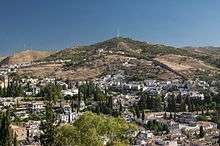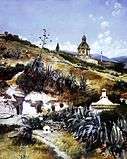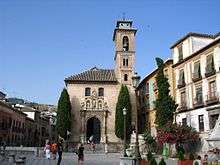Sacromonte
Sacromonte, sometimes also called Sacramonte, is a traditional neighbourhood in the eastern area of the city of Granada in Andalusia, Spain. It is one of the six neighbourhoods that make up the urban district of Albayzín and borders the neighbourhoods of Albayzín, San Pedro, Realejo-San Matías, El Fargue and Haza Grande.

.png)
It is located on the hillside and in the valley of Valparaíso, opposite the Alhambra - emblem of Granada. The neighbourhood occupies both banks of the Darro river, whose name seems to be derived from the phrase "d'auro" ("of gold") because of its famous gold-bearing sediments.
Traditionally the neighborhood of the Granadian Romani, who settled in Granada after the Christian conquest of the city in 1492, it is one of the most picturesque neighbourhoods of the city, with cave houses installed in whitewashed caves.[1]
The Romani of Sacromonte have a mixed language known as Caló, which has seen a rapid decline in use over the past century. It is derived from India, where the Romani originated. The Romani of Sacromonte were famously portrayed by the poet Federico García Lorca in his book of poems Romancero Gitano.
Etymology
The neighborhood owes its name to an episode which occurred between 1595 and 1599 on the hill of Valparaíso: the supposed discovery of relics and the so-called "lead books" or "Lead Books of Sacromonte", containing indecipherable drawings and texts in Latin and Arabic characters, which came to be interpreted by some as the fifth gospel. These findings were declared a forgery in the 17th century, but nonetheless led to the construction of the Abbey of Sacromonte, where the supposed relics of Saint Caecilius (co-patron of Granada) and the lead books are now kept.
Origin of the caves
The origin of the houses excavated on the slopes of Sacromonte, the traditional dwelling type of the neighborhood, is not very clear. It is assumed that they began to be built from the 16th century, after the Jewish and Muslim populations were expelled from their homes, and intermixed with the nomadic Romani, adopting some of their customs. The caves became housing for the marginalized, located outside the walls of the city, which meant being outside of administrative and ecclesiastical control, particularly the Spanish Inquisition. To dig a cave it was necessary to carve away a part of the face of the hill where they wanted to build, making a vertical cut that served as a facade. The builder then inserted an arch at the midpoint to serve as a door. They then excavated as much space for rooms as the terrain would allow.
The forms and limits of this unique house type are determined by the terrain, altitude and extent of the hills where the excavation takes place, so there are no two identical caves. These elements, along with the paths, gullies, small squares, whitewashed facades and interiors form a unique landscape, alongside the customs and crafts of their inhabitants, giving the neighbourhood a unique character.
In addition to the troglodyte houses, another important feature of the neighbourhood is the legends that relate to all corners and places, one of the most well-known being the Ravine of the Blacks.
.jpg) The caves of the Gipsies at Sacromonte by Gustave Doré in L'Espagne
The caves of the Gipsies at Sacromonte by Gustave Doré in L'Espagne El trato by the Granadan Isidoro Marín Gares (1863 - 1926)
El trato by the Granadan Isidoro Marín Gares (1863 - 1926) Dome of the Abbey of Sacromonte and caves dwellings by Antonio Gomar y Gomar (1849 - 1911). Currently this dome of the Sacromonte Abbey is derelict.
Dome of the Abbey of Sacromonte and caves dwellings by Antonio Gomar y Gomar (1849 - 1911). Currently this dome of the Sacromonte Abbey is derelict..jpg) View of the Alhambra from the cactuses of Sacromonte by Francesco Xavier Parcerisa in 1850, in Recuerdos y bellezas de España.
View of the Alhambra from the cactuses of Sacromonte by Francesco Xavier Parcerisa in 1850, in Recuerdos y bellezas de España.
A neighbourhood legend: Ravine of the Blacks (Barranco de los Negros)
Popular legends hold that after the loss of Granada to the Catholic Monarchs in the Granada War, the formerly ruling Arabs - who made their way in exile to African lands - never gave up hope of someday returning to the city of their parents and grandparents, where they and their children were born.
Afraid of being preyed upon by bandits or groups of renegade Christian soldiers on the roads to the ports of Almuñécar or Almería, where they embarked for Africa, they hid great treasures among the olive groves which at the time covered Sacromonte.
At the same time, they granted freedom to the many slaves owned by the noble Arab families, because of the expense and difficulty of performing the journey with a large entourage. Many of these slaves were black, and had noticed the comings and goings of their former owners to Mount Valparaíso (as the area was then called), were aware of their former owners' fears and had overheard many conversations between them regarding burying their possessions. Granted their freedom but without work or belongings, many decided to climb the mountain and recover for themselves the treasures that had once belonged to their former owners.
They dug and dug into the slopes of the ravine reportedly without success, and exhausted by the effort but left with no alternative shelter, decided to condition the resulting caves and make them their homes. This gave the area the name of "Ravine of the Blacks", as these were believed to be the first inhabitants.
In later years, as Roma began to settle in the area, they supposedly attempted to use many spells in search of the exact places where the treasures were hidden. Many older witches, known as ferminibí, were reported to try talking with water and others with fire, or staring unblinking into basins of water, trying to get some clues to the locations of the lost treasures. To this day it is unknown whether any were discovered and secretly taken away by treasure seekers, or if the treasures remain hidden in the area.
Other sights

Abbey and College of the Sacromonte; Holy Caves
In addition to the numerous caves, the main monument of the neighbourhood is the Abbey of Sacromonte, built by Archbishop Pedro de Castro y Quiñones in 17th century near the summit of the hill, where the alleged relics and other remains of the first Christians of Granada and evangelizers of Roman Baetica; including Saint Caecilius, martyr and first bishop of the city in the 1st century CE; and other apostolic figures including companions of Saint James, were discovered. The College of Sacromonte was founded by Pedro de Castro as an annex to the abbey.
The abbey consists of the abbey itself (17th century), the Old College of San Dionisio Areopagita (17th century), the New College (19th century) and the "Holy Caves" (Santas Cuevas).[2] The abbey has an important library with numerous incunabula and manuscripts, but which is currently closed to the public. The Santas Cuevas are old catacombs which contain several chapels. In one of these, according to tradition, James the Less officiated. This is where the festival of Saint Caecilius takes place.
The abbey also contains the School of the Holy Mary, founded by teacher and priest Andrés Manjón - known as Padre Manjón - at the beginning of 20th century to teach Romani children, and whose pedagogical innovations are still in use.
The abbey is the canonical seat of the Confraternity of the Romani. Mass is celebrated every Sunday at noon.
Other buildings
In Carrera del Darro there are numerous monuments, including:
- The Arabic Casa de Zafra, built at the end of the 14th century and which now serves as the headquarters of the Centro de Estudios Históricos.
- Casa de Castril, dating from the 16th century, which has beautiful Mudéjar coffers and a plateresque facade. The building is currently operated by the Archaeological and Ethnological Museum of Granada.
- Convento de Santa Catarina de Zafra, founded in 1520, which includes a small preserved Arab house of the 11th century.
- Palacio de los Córdova, built by the Dukes of Montellano, currently housing the Archive of Granada.
- Iglesia de San Gil y Santa Ana, a 16th century church.
- El Bañuelo or Bath del Nogal or de los Axares, a hamam (bathhouse) built on the Darro river in the 11th century during the reign of the Zirid King Badis ben Habus, one of the most well-preserved in Spain.
- Fountain del Avellano, made famous by the works of Ángel Ganivet.
- The Museum Caves of Sacromonte, an ethnographic museum.
Fiestas
- Granada celebrates the Fiestas de San Cecilio (Saint Caecilius) on the first Sunday in February with a pilgrimage to Sacromonte; the Carnival, also in February; and the Día de Mariana Pineda in May grows more important each year. Holy Week has rapidly achieved great importance. The neighbourhood of Sacromonte celebrates its own neighbourhood fiestas for the first ten days of August.
Native cuisine
- Tortilla del Sacromonte
Famous Sacromontinos
- Mariana Pineda
- Chorrojumo
Notes
- Translated from the Portuguese and Spanish Wikipedias
References
- "Discover the Albayzín and Sacromonte". Granada Spain. 1 May 2013. Retrieved 4 September 2018.
- Hierro Calleja 2004, p. 113
- "Definición de zambra en el DRAE".
External links
| Wikimedia Commons has media related to Sacromonte. |
- Flamenco recording from 1962 in Sacramento
- The Wise Men of Sacromonte, 2013 documentary
- http://granadamap.com/abadia/indexsp.htm (in Spanish)
- http://servicios.ideal.es/guia/abadia.html (in Spanish)
- http://granadainfo.com/canastera/cdesacroen.htm (on the Romani caves)
- http://www.sacromontegranada.com/?lang=en Museum caves of the Sacromonte's website